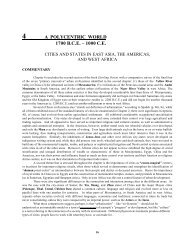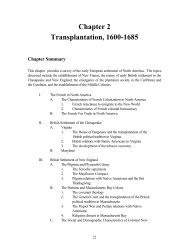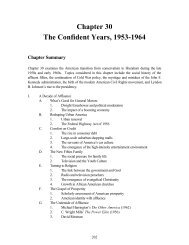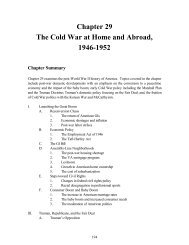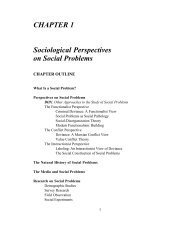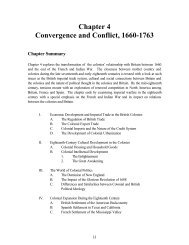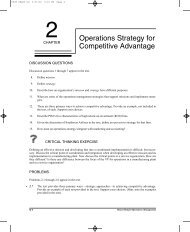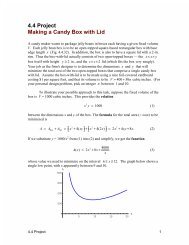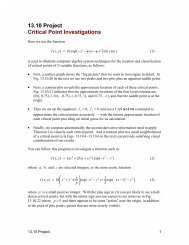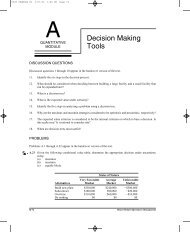Merchandising Operations and the Accounting Cycle - Pearson
Merchandising Operations and the Accounting Cycle - Pearson
Merchandising Operations and the Accounting Cycle - Pearson
You also want an ePaper? Increase the reach of your titles
YUMPU automatically turns print PDFs into web optimized ePapers that Google loves.
Supplement to Chapter 5<br />
<strong>Accounting</strong> for Merch<strong>and</strong>ise in a<br />
Periodic Inventory System<br />
Purchasing Merch<strong>and</strong>ise<br />
in <strong>the</strong> Periodic Inventory System<br />
Some businesses find it uneconomical to invest in a computerized (perpetual) inventory<br />
system that keeps up-to-<strong>the</strong>-minute records of merch<strong>and</strong>ise on h<strong>and</strong> <strong>and</strong> cost<br />
of goods sold.<br />
Recording Purchases of Inventory<br />
All inventory systems use <strong>the</strong> Inventory account. But in a periodic inventory system,<br />
purchases, purchase discounts, purchase returns <strong>and</strong> allowances, <strong>and</strong> freight costs<br />
are recorded in separate expense accounts bearing <strong>the</strong>se titles. Let’s account for<br />
Austin Sound Centre Inc.’s purchase of <strong>the</strong> JVC goods in Exhibit 5S-1. For <strong>the</strong> moment,<br />
disregard GST <strong>and</strong> use <strong>the</strong> invoice total of $707.00 when recording purchases<br />
<strong>and</strong> purchase discounts. GST is discussed on page 234. The following entries record<br />
<strong>the</strong> purchase <strong>and</strong> payment on account within <strong>the</strong> discount period:<br />
May 27 Purchases ................................................................... 707.00<br />
Accounts Payable................................................ 707.00<br />
Purchased inventory on account.<br />
June 10 Accounts Payable........................................... 707.00<br />
Cash............................................................ 685.79<br />
Purchase Discounts ($707.00 × 0.03) ...... 21.21<br />
Paid for inventory on account within discount period.<br />
The discount is $21.21.<br />
Recording Purchase Returns <strong>and</strong> Allowances<br />
Suppose instead that prior to payment, Austin Sound returned to JVC goods costing<br />
$70 <strong>and</strong> also received from JVC a purchase allowance of $10. Austin Sound<br />
would record <strong>the</strong>se transactions as follows:<br />
June 3 Accounts Payable ..................................................... 70.00<br />
Purchase Returns <strong>and</strong> Allowances ................... 70.00<br />
Returned inventory to seller.<br />
June 4 Accounts Payable ..................................................... 10.00<br />
Purchase Returns <strong>and</strong> Allowances ................... 10.00<br />
Received a purchase allowance.<br />
During <strong>the</strong> period, <strong>the</strong> business records <strong>the</strong> cost of all inventory bought in <strong>the</strong><br />
Purchases account. The balance of Purchases is a gross amount because it does not<br />
include subtractions for purchase discounts, returns, or allowances. Net purchases<br />
is <strong>the</strong> remainder computed by subtracting <strong>the</strong> contra accounts from Purchases:<br />
Purchase (debit balance account)<br />
– Purchase Discounts (credit balance account)<br />
– Purchase Returns <strong>and</strong> Allowances (credit balance account)<br />
= Net purchases (a debit subtotal, not a separate account)<br />
OBJECTIVE S2<br />
Account for <strong>the</strong> purchase <strong>and</strong><br />
sale of inventory under <strong>the</strong><br />
periodic inventory system<br />
KEY POINT<br />
A contra account always has a<br />
companion account with <strong>the</strong><br />
opposite balance. Thus both<br />
Purchase Discounts <strong>and</strong> Purchase<br />
Returns <strong>and</strong> Allowances (credit<br />
balances) are reported with<br />
Purchases (debit balance) on <strong>the</strong><br />
income statement.<br />
Chapter Five <strong>Merch<strong>and</strong>ising</strong> <strong>Operations</strong> <strong>and</strong> <strong>the</strong> <strong>Accounting</strong> <strong>Cycle</strong> 279



